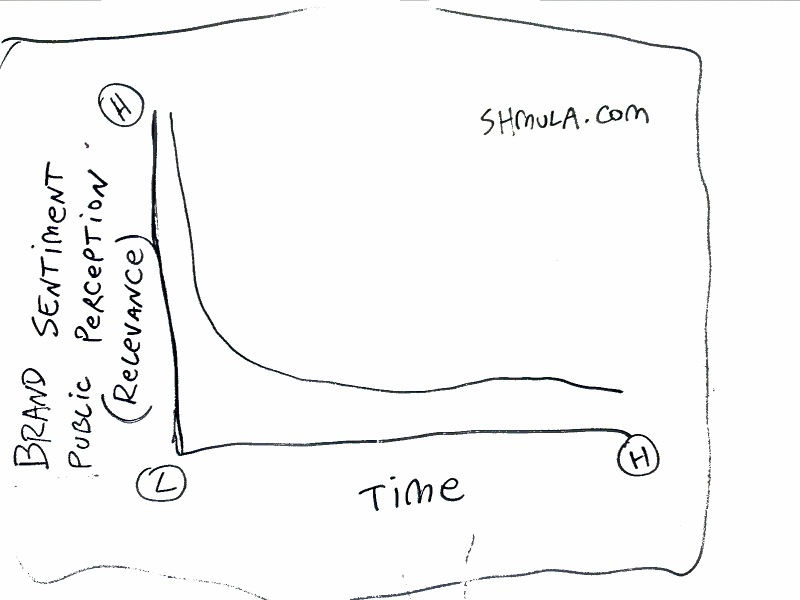A few weeks ago, I posted on my experience with Twitter, Part 1. That post was retweeted by Robert Scoble, the traffic came, got a bunch of new followers on Twitter (welcome folks), and a flurry of passionate comments on the post, including 3 comments from Guy Kawasaki.
Then, I posted on My Experience with Twitter, Part 2, followed by My Experience with Twitter, Part 3, where I offended @darthvader.
Today, is Part 4 of that series on Twitter, Brand Relevance & Brand Intelligence, and Cash Money.
Google is a great search engine, but it is, by de facto, historical. For example, just by the virtue of the knowledge aggregation process employed by Google, as content hits the web, there is latency in indexing that content. That very fact makes knowledge based on history.
One area that Twitter has a distinct advantage is in the collection, aggregation, and dissemination of current, real-time, information. Twitter, as an early feedback system, is valuable to brands in many, many ways. Here are a couple of ideas:
- Pharmaceutical & Medical Device: In these industries, there are, by regulation, monitoring systems in-place as new drugs or medical devices are approved by the Food and Drug Administration (FDA) and enter the market. Twitter can be a very effective and cost-effective monitoring system for Pharmaceutical and Medical Device companies.
- Market Research: As companies develop new products, these products can be released carefully to a select number of twitterers that act as an army of word-of-mouth buzz agents. For example, suppose I have a new product called shmula wire (a type of energy drink). I can recruit a sample of twitterers, give each of them 10 shmula wire products with the commitment that they would give each of those to other twitterers and, hope, that they, collectively, will tweet about shmula wire. This is literally word-of-mouth that is designed and, because it is within a buzz-system, this data is captureable, measureable, and relevant. This is huge.
- Net Promoter Score (NPS) is designed to be a market monitoring, customer loyalty system. But, the latency involved in reading verbatim comments and the increasing debate around the score itself causes companies to forget the customer in favor over methodology.
- Other feedback systems such surveys (inbound or outbound) have some barrier to entry involved. Twitter is easy, self-reported, and brutally honest.
- Communication: This is obvious, but what might be helpful for brands is the notion of pre-wiring the public of an upcoming brand to see what the customer reaction will be. For example, prior to Coke releasing a new product called shmula wire (again, the energy drink), Coca-Cola might want to release a tweet about shmula wire to see what the reaction might be. Based on the public reaction, Coca-Cola can make a more intelligent decision on product roll-out, messaging, and sentiment.
- Government: The Government can monitor sentiment on a public figure, a new bill, a law, or even activities related to national security. Twitter can be a very dangerous vehicle for terrorist; you get the picture.
- Centers for Disease Control: Similar to the (1) above, the CDC can also monitor peanut butter salmonella outbreaks or other similar public health concerns.
The above are just some ideas for how Twitter can be more valuable to brands and also how Twitter can monetize this very valuable service. All of the above is based on this assumption:
Brand Sentiment and Public Perception is a Function of Time; that is, the center of gravity for a brand is greatest when it is more recent. Over time, brand sentiment loses relevancy.
Graphically, it might look something like the following:

In other words, Peanut Butter Salmonella outbreaks is most important and relevant closer to the event. It loses importance and relevance the further we get from the event. The real-time, feedback system that Twitter has become an authority in is ideal for anything that is contingent upon Relevance and Time. This includes events, brands, products, etc. This opportunity also presents the potential monetizing-yet-untapped power of Twitter.








Buzz and what people we talking about at the “water cooler” used to be considered a desirable result with happenstance regarding the liklihood of generating either. Now, they are truely becoming the direct product of a methodical process.
In a public lecture I gave 7-8 years ago at Empire State College on Technology and Society, I noted that the interconnection of people through the communication infrastructure leads topeople knowing more about people that they had never met (and may never meet) than the people living down the street. Exciting and scary at the same time. MySpace, Facebook and Tweeter all are tools for nearly instantaneous (due to the geometric growth as you send a message out through followers/friends)dissemination and if set-up to capture it feedback.
Pete,
Interesting thoughts.
How would you address the issue of relevant permanence. If you were the CDC and dealing with real time information for an outbreak – how are those messages not lost in the stream?
Do you rebroadcast? Do you invent a reader that can have tweets with expiry times?
My worry is that vital information will slip by when people are tweeting real time basketball scores or something.